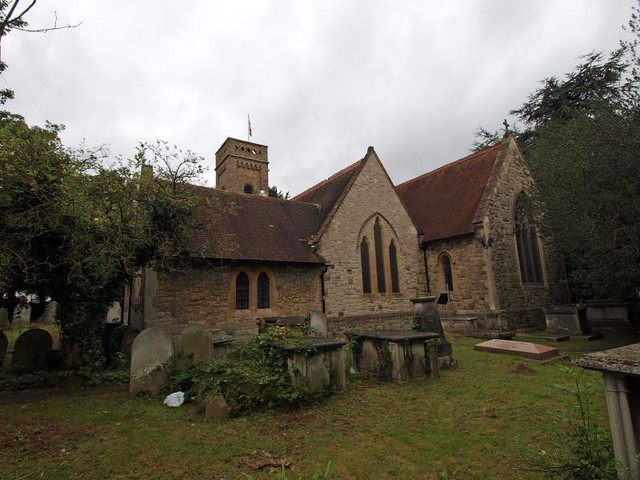I was looking forward to this, having, unusually, done some research and was seriously disappointed although the churchyard was interesting.
ST MARY, Church Hill. Nave walls and three small windows in the N wall, Norman. The rest C19. Tower of yellow brick in a Neo-Norman style, aisle 1868, chancel 1880. - PLATE. Cup of 1636. - Fine graveyard, with old cedar tree S of the church tower. In the graveyard MONUMENT to John Sharpe d. 1756, large urn on big base under a heavy arched baldacchino.
Eastwards of the London road are East Barnet and Friern Barnet; in both places the chief building of interest is the church. East Barnet is dedicated to Our Lady and is the mother church to which St John’s at Chipping Barnet was once a chapel of ease. The nave walls and three small windows in the north wall are all that remains of the Norman church - the rest is late 19th century and the most remarkable thing about the church is its, commanding position, for it looks out from the top of Church Hill across Pymmes Brook. A number of famous men are buried at East Barnet. Sir George Prevost was Governor General of Canada in 1812 during the last war between America and England. Of Swiss descent, he had opposed France on England’s behalf in the West Indies and had been rewarded with governorships there, but his appointment in Canada did not go well, for he intervened in military operations and was summoned to London for court martial but died, broken with anxiety, before the trial could be held. His father, General George Prevost, is buried beside him.
Another father and son are here too - Daniel Beaufort who helped to found the Royal Irish Academy and who prepared a map of Ireland, and Admiral Sir Francis Beaufort, who drew up the table of winds still in use today and still known as the Beaufort Scale. Another benefactor of seamen lies here - John Hadley (1682-1744), son of a wealthy Londoner who was elected a Fellow of the Royal Society at the age of 35 and who produced the first reflecting telescope powerful enough to study the stars, and the reflecting quadrant which is still called by his name.
Near to the church in Park Road is the Abbey Arts Centre and Museum, where a collection of far eastern and primitive art is housed in a rebuilt 13th century tithe-barn which stands in an attractive garden with a well. The collection is open to the public on Saturday afternoons or by appointment. A visitor to the neighbourhood might well go on to admire Monkfrith Avenue Infants School, an outstandingly good example of modern architecture.
Another father and son are here too - Daniel Beaufort who helped to found the Royal Irish Academy and who prepared a map of Ireland, and Admiral Sir Francis Beaufort, who drew up the table of winds still in use today and still known as the Beaufort Scale. Another benefactor of seamen lies here - John Hadley (1682-1744), son of a wealthy Londoner who was elected a Fellow of the Royal Society at the age of 35 and who produced the first reflecting telescope powerful enough to study the stars, and the reflecting quadrant which is still called by his name.
Near to the church in Park Road is the Abbey Arts Centre and Museum, where a collection of far eastern and primitive art is housed in a rebuilt 13th century tithe-barn which stands in an attractive garden with a well. The collection is open to the public on Saturday afternoons or by appointment. A visitor to the neighbourhood might well go on to admire Monkfrith Avenue Infants School, an outstandingly good example of modern architecture.

No comments:
Post a Comment